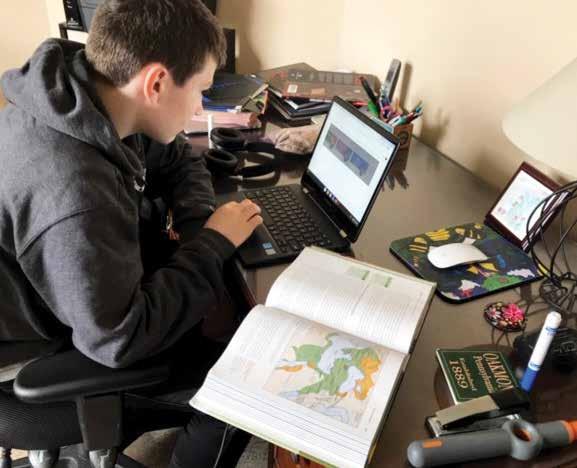
12 minute read
An Unprecedented Upheaval
An Unprecedented
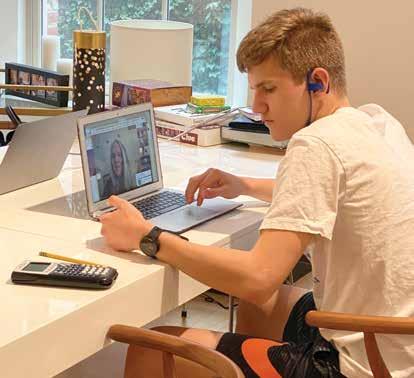
By Eric Krebs ’17
On Sunday, March 8, New York City reported 21 new cases of COVID-19, about the population of an average classroom at Xavier. By Thursday, March 12, there were 357 new cases per day, more than an entire class year. By the 15th, new daily cases outnumbered the entire student body.
“On the night of March 11, Mr. Raslowsky and I had a conversation, and both of us decided that this was far more serious than we had been led to believe. We began to worry about our families and the safety of our kids, so we made the decision to close,” Headmaster Michael LiVigni P’21 recalled. The next day, Thursday, March 12, would be Xavier’s last day of in-person instruction. On Friday, March 13, members of the faculty and staff came to Xavier for intensive, collaborative preparation to transition to distance learning. “In our minds, we’d be back after Easter break...but that’s not what happened,” LiVigni said.
This is the story of what did happen, how administrators, teachers, faculty, and students adapted to—and made the most of—a truly unprecedented upheaval.
O“ nce it became clear that closing was a real possibility, [Dean of Faculty] Brian McCabe P’23, [Dean of Academics] Lou Lovallo, and I began really hammering out what the daily, weekly plan would look like...and it wasn’t the logistics that came first. What came first was a discussion of our priorities,” Dean of Educational Systems Lindsay Willert told Xavier Magazine. Early meetings between the three deans lasted hours, covering different possible scenarios and how the school might adapt to each. Existing models for online learning, said Willert, mostly catered to the university level. Xavier, thus, had both the opportunity to learn from best practices and innovate its own.
As it turned out, innovation that has been going on at Xavier for a decade helped prepare them to do exactly that. “We’ve been working on a different paradigm at Xavier,” McCabe
Upheaval
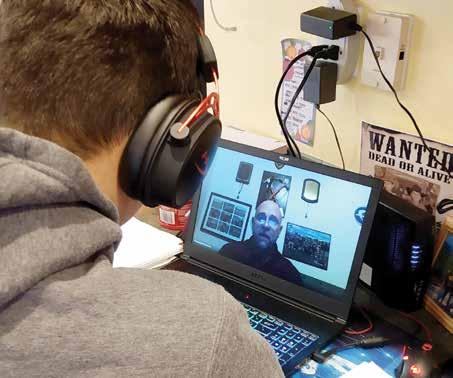
From its near two-century-deep roots in Lower Manhattan to its commitment to two millennia of Christian teaching, Xavier High School has a long history of holding fast as the world outside its windows changes. But even the most steadfast institutions must, from time to time, change. This spring, with the outbreak of COVID-19, Xavier underwent a change unlike any other in its history—Xavier went digital.
Caedmon Deem ’22 completed his first two days of online learning in Pittsburgh, where his family had traveled to move his older brother Christian Deem ’19 out of his Carnegie Mellon University dorm.
McAllister Whiting ’21 listens as Mary-Grace Gannon P’03 ’07 leads a discussion about Death of a Salesman, Act I in AP English Language and Composition.
Billy Bissell ’21 listens to a history lesson recorded by Chris Stevens ’83.
said. “Teachers typically become teachers because they fall in love with a subject and want to share that love.” Designing curriculum typically starts from there, as teachers select the topics and lessons they want to teach. The paradigm Xavier works from, McCabe noted, is the opposite of the typical “input” method. Instead, teachers work backwards from desired outcomes, and decisions about testing, essays, and content are all downstream from those essential questions. “Of all the things we have to teach, [we ask] ‘what are the most important things for these students to learn right now?’ And this situation really forced us more than ever before to ask those questions,” said McCabe.
“We had to assess the needs of our community,” said LiVigni. “We had to make sure that whatever we did was accessible to students with different access to technology… and, you know, it’s New York. We have kids living five or six people in two-bedroom apartments, with not a lot of space, sometimes younger siblings around, and who knew if mom or dad would be around?” Concerns over the varied needs and situations of students guided the school’s decision to adopt an asynchronous model of learning, where teachers would pre-record lessons available for students to watch at their convenience, with face-to-face office hours and assignments built into the schedule. Even then, teachers would have only a fraction of the classroom time they normally have, so lessons had to be pared down and reshaped to fit the new constraints.
A new medium, a new environment, and new lessons—all in two weeks of planning. Despite the monumental challenge, teachers rose to the occasion. “When I think about how far we’ve come, I get a tremendous sense of consolation. It’s been amazing,” said McCabe.
It was never easy, however. One week after announcing Xavier’s transition to distance learning, classes resumed online on March 19 as students and teachers alike adapted to a classroom unlike any other they had ever experienced. That day, Director of Campus Ministry Kaija DeWittAllen sent out the first in a series of daily prayers, with an excerpt from St. Paul’s letter to the Hebrews:
“And let us consider how to provoke one another to love and good deeds, not neglecting to meet together, as is the habit of some, but encouraging one another, and all the more as you see the Day approaching. Do not, therefore, abandon that confidence of yours; it brings a great reward. For you need endurance, so that when you have done the will of God, you may receive what was promised.”
Confidence and endurance, as it turned out, were certainly needed. “Distance learning was a challenge for everyone in the faculty, from fledgling to veteran,” Vicente Vargas told Xavier Magazine. Vargas, an instructor in the modern and classical languages department, is Xavier’s most senior teacher, having first arrived on 16th Street in 1982. “I have been in the classroom for almost 40 years, and the thought of having to teach into a screen filled
1.

2.
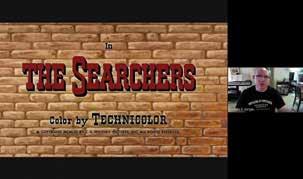
1. Andrew Gheraldi narrates a lesson about William Shakespeare.
2. Vicente Vargas presents a live lecture about the classic film The Searchers, a John Ford-directed Western starring John Wayne, Jeffrey Hunter, and Natalie Wood.
with digitized images of my students put me right back to the first time I stepped into a classroom,” he said.
But for as much as the new environment was daunting, it also presented an opportunity for teachers to experiment. “We have a pretty senior department,” noted Ed Young P’22, chair of Xavier’s history department. (The four most senior members of that department— Young, Chris Stevens ’83, Patrick Dormer P’17, and Joe Sweeney ’85 P’23—have 107 years at Xavier between them, but year 108 evidently wasn’t too late to start again.) “From the beginning, the conversation was, ‘This is an opportunity to do stuff that we wouldn’t normally be able to do.’ We asked, ‘What stuff is interesting? How do we offer a worthwhile online learning experience?’”
Mary-Grace Gannon P’03 ’07, a teacher in the English department, echoed Young’s sentiment. From Google Classroom to Adobe Spark, Flipgrid, PowerPoint, and beyond, online learning provided a new—albeit daunting—set of tools to augment the classroom. “It hurts a bit because we are in that liminal space where things are uncertain, uncomfortable, and we feel unsure. Yet this is the place where we do our best growing. The exciting part of the whole endeavor has been learning new ways to teach, reach, and engage our students.”
For students and parents alike, adapting to new ways of connection didn’t come immediately.
“In the beginning, there was an adjustment period of being physically away from the building and not in the presence of the community,” Director of Alumni Relations Zane Massey ’96 P’22 reflected on his son Zane Massey II ’22’s learning experience. “Ultimately, he got into a good rhythm and it actually had some positive outcomes as well. It was an exercise in him being more accountable for his work. In a negative situation, it presented a real opportunity.”
The adaptation of each course, whether math, religion, or English, varied greatly with each teacher and class finding their unique equilibrium. In the case of Matthieu Forgeas ’20, it helped him feel both excited by the new and comforted by the familiar: “[My AP European History teacher] Mr. James Costa ’02 did not try to adapt traditional in-class learning to remote learning. Instead he utilized the full potential of the technology at his disposal to create an entirely new way to learn,” Forgeas told Xavier Magazine. In contrast, Forgeas’ Christian Ethics on War and Peace teacher, Brian McCabe, sought to recreate a more traditional class experience, which, to Forgeas, “brought a sense of normality to the confusion of societal lockdown.”
It was that sense of normality, however, that continued to elude many teachers and faculty, for whom no amount of pixels could replicate the energy and community of a classroom full of students. “I miss them. I miss the group dynamic,” admitted LiVigni, who in addition to his role as headmaster teaches a course on journalism. “I love our guys, and I miss being around them. I miss the interactions they have with each other, and trying to capture that is somewhat impossible,” he confessed.
As LiVigni attested, he’s not alone in feeling so. “Universally, [the teachers] miss the kids. That doesn’t surprise me, but the depths of how much they miss the kids is not only heartwarming but it’s surprising. It’s all they really talk about,” he added. The sense of communal loss was not only between teachers and students, but within the faculty itself. Many teachers have set up their own video calls, virtual breakrooms, and opportunities to connect with each other, like LiVigni’s 10 a.m. “coffee clubs,” a weekly Rosary led by Jim Hederman, S.J. each Thursday on Google Meet, and online meetups organized by the faculty “Sunshine Committee.”
That sense of community was kindled beyond the (digital) classroom, as well.
Over the course of the spring, the guidance department made sure to call and check in with every student, and, to help give the senior class a proper sendoff, 55 faculty and staff members hand-delivered gift bags to nearly every member of the graduating class, even across state lines.
With physical togetherness out of the picture, Xavier’s renowned athletics programs have been hit particularly hard by remote learning. But that hasn’t stopped the community from finding new ways to stay fit and stay connected.
“The coaches and I moved very quickly. We had a couple of meetings and decided we had to put something together to keep the guys active and engaged,” recalled Andrew Gheraldi, Director of Athletics. “What we came up with was the Xavier Athletics Color Wars.” Athletes were split into teams by their age group, and each team could earn points by the quantity and quality of workout videos they submitted. In addition, a specific workout was featured on the Knights Knation Instagram page each day. The competition lasted from March to the end of the year, with the Maroon Baseball team winning the title in a showdown against the Blue Tennis team. “I’m extremely thankful for our dedicated coaches who really gave the boys something to strive
for and kept them active and engaged along the way,” Gheraldi added. “I’m proud of how engaged our student body was.”
Students’ engagement didn’t go unnoticed back in the classroom, either. “The continued effort that the guys put in blew me away,” Ed Young noted. “I mean, they never stopped working.” And safe to say, at least to Israel Pierre ’20, the feeling was mutual. “The key aspect isn’t just the academic rigor or the classes, but also the social interaction. Teachers tried to replicate some semblance of community—and I could see the effort put in. Online learning emphasized how much Xavier makes the work feel more manageable, and the spirit of that makes it easier to do work in collaboration with others.”
Reflection was a key theme for everyone at Xavier this spring. For students like Pierre, online learning illuminated just how crucial the Xavier community is to their academic success. For students like Forgeas, online learning—above all—reminded him just how much he missed his friends.
For teachers across Xavier, many found the transition to be an opportunity to reflect on what it means to be a teacher in the first place. “We are finding that our new role, more than ever before, is to curate the class experience in new and creative ways so that students aren’t floating around on the web feeling lost or simply ‘doing homework’ to get it done and get a grade. There is so much available now online that it is more important than ever that the students have a guide and curator so they can access the best tools, materials, and content for their development as thinkers, writers, and creators,” Gannon noted.
An integral part of LiVigni’s reflections on the spring, especially looking forward to a hybrid learning model this fall, is recognizing what simply cannot be recreated online. “I think online learning is more than a mutation of the inperson,” he said. “I really think it’s two separate ways of teaching. It’s a different skill set.”
For faculty, staff, and students alike, Xavier’s great leap into the digital unknown has brought about a singular realization—in a pandemic, everyone is a student. “As a teacher, you don’t have the luxury of saying, ‘I can’t do this,’” Young reflected. “It’s been a good reminder of how important it is to model to kids yourself as a learner. How do you demonstrate resilience? How do you adapt?”
Whether learning how to share a screen, how to keep up relationships over Google Meet or Zoom, how to deal with unprecedented hardship, or, ultimately, how to maintain the hope and drive to keep going in a time as 2. dark as this, Xavier’s transition to online learning brought together every member of the community in a concerted effort to make the best of a trying time and, ultimately, to learn.
As Gannon put it, “When we are pushed into the deep end, we have to learn to swim.”
1.
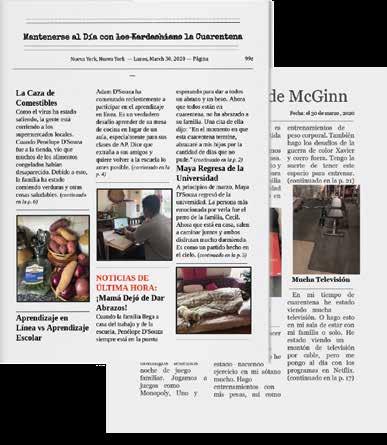
1. Students in Colleen Rober’s Spanish 4 class created front pages of imaginary newspapers depicting their lives in quarantine. Examples written and designed by Adam D’Souza ’20 and Thomas McGinn ’20 are featured above.
2. For their final project, students in Andrew Bodo’s Latin 3 class researched a Greek or Roman myth to adapt and rewrite in comprehensible Latin, then created a storybook version in Adobe Spark. Ryan Wong ’21 created the example below.








